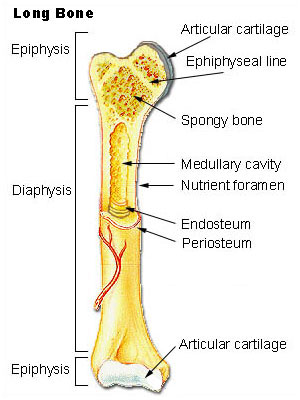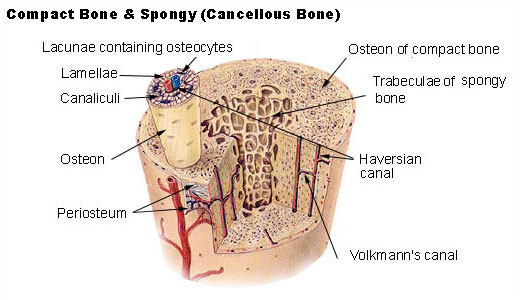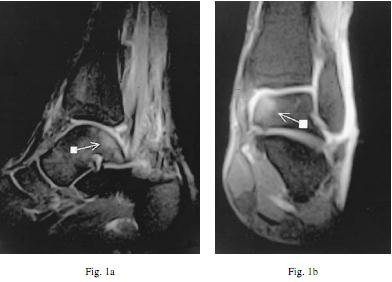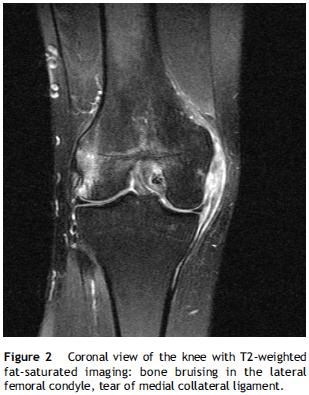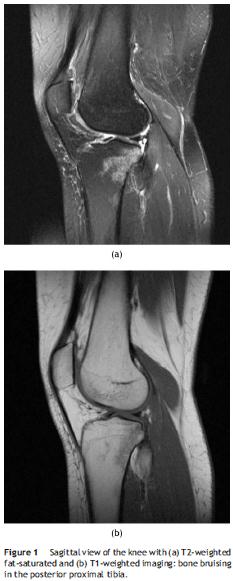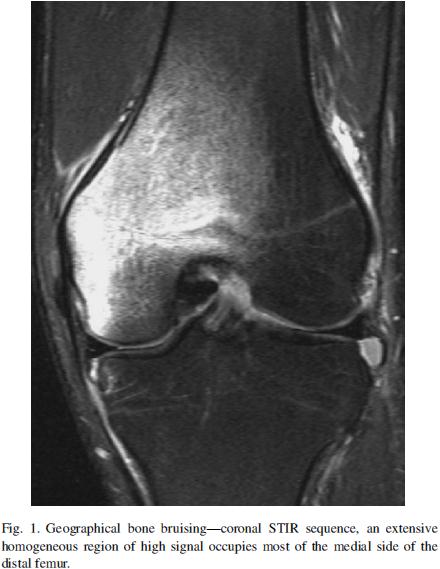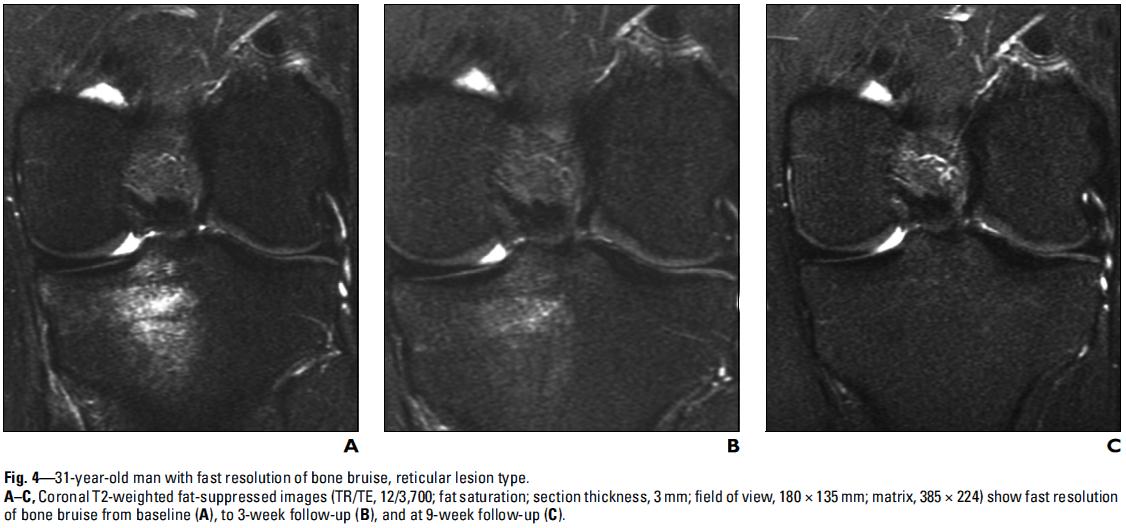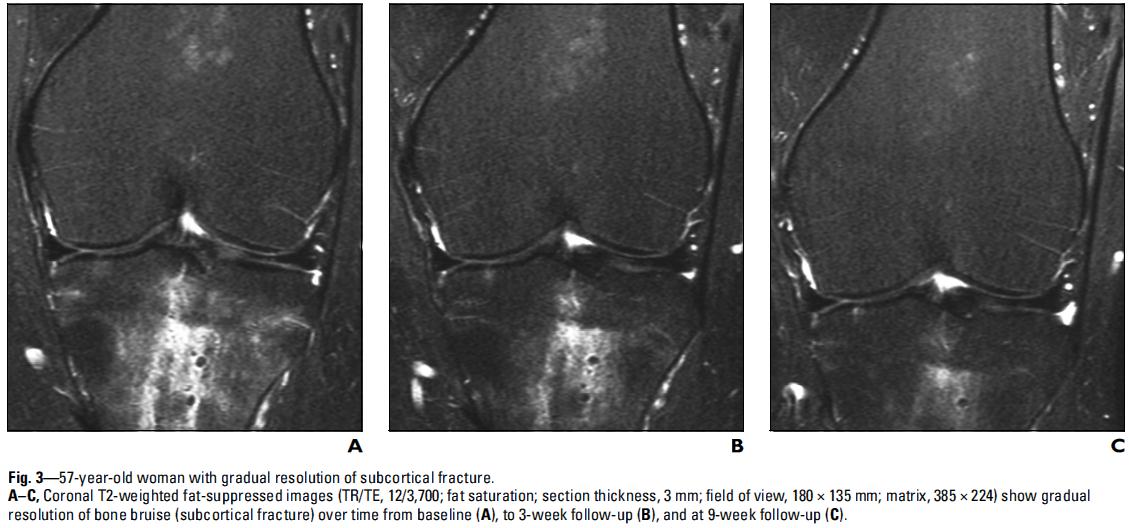Bone bruise: Difference between revisions
Claire Knott (talk | contribs) No edit summary |
Claire Knott (talk | contribs) No edit summary |
||
| Line 24: | Line 24: | ||
<br> | <br> | ||
== Epidemiology | == Epidemiology == | ||
The most common cause of bone bruise is acute trauma however this condition can also be associated with normal stress loading and haemophilia A and B.<sub><ref name="p52">Prof. Dr. S. Van Creveld and Dr. M. Kingma Subperiostal haemorrhage in haemophilia A and B. Ned. T. Geneesk. 105. I. 22. 1961; 1095-1098 Grades of recommendation F</ref></sub> | The most common cause of bone bruise is acute trauma however this condition can also be associated with normal stress loading and haemophilia A and B.<sub><ref name="p52">Prof. Dr. S. Van Creveld and Dr. M. Kingma Subperiostal haemorrhage in haemophilia A and B. Ned. T. Geneesk. 105. I. 22. 1961; 1095-1098 Grades of recommendation F</ref></sub> | ||
| Line 171: | Line 171: | ||
http://bruises.knowingfirstaid.com/permalink.php?article=Bone%20Bruises.txt</ref></sub><br>The time for the resolution of a bone bruise is variable. At its earliest the bruise will be gone 3 weeks after the acute trauma. In all cases the bone bruises disappeared at 2 years after the trauma.<sub><ref name="p3">V. Mandalia, A.J.B. Fogg, R. Chari, J. Murray, A. Beale, J.H.L. Henson. Bone bruising of the knee. Clinical Radiology 2005; 60, 627–636 Grades of recommendation:A</ref><ref name="p6" /></sub><br><br> | http://bruises.knowingfirstaid.com/permalink.php?article=Bone%20Bruises.txt</ref></sub><br>The time for the resolution of a bone bruise is variable. At its earliest the bruise will be gone 3 weeks after the acute trauma. In all cases the bone bruises disappeared at 2 years after the trauma.<sub><ref name="p3">V. Mandalia, A.J.B. Fogg, R. Chari, J. Murray, A. Beale, J.H.L. Henson. Bone bruising of the knee. Clinical Radiology 2005; 60, 627–636 Grades of recommendation:A</ref><ref name="p6" /></sub><br><br> | ||
== References == | == References == | ||
| Line 198: | Line 179: | ||
[[Category:Sports Medicine]] | [[Category:Sports Medicine]] | ||
[[Category:Sports Injuries]] | [[Category:Sports Injuries]] | ||
[[Category:Primary Contact]] | |||
Revision as of 13:06, 12 November 2018
Original Editors - Laurien Henau as part of the Vrije Universiteit Brussel's Evidence-based Practice project.
Top Contributors - Laurien Henau, Claire Knott, Rik Van der Hoeven, Admin, WikiSysop, Kim Jackson, Wanda van Niekerk, Lucinda hampton and 127.0.0.1 - .
What is a bone bruise?[edit | edit source]
A bone bruise is one of the four types of fractures that can occur in the human body. Other fracture types include stress fractures, osteochondral fractures and bone fractures.[1] A bone bruise can be described as one or a combination of the three different kinds of bone injuries including: sub-periosteal hematoma, inter-osseous bruising and a sub-chondral lesion. [2] A bone bruise is differentiated from the alternative fracture types in that only a few of the trabeculae are broken.[3]
Clinically Relevant Physiology[edit | edit source]
Bone tissue is a specialised form of connective tissue that is made up of an organic matrix (collagen and glycosaminoglycans) and inorganic minerals (calcium and phosphate). [4] An adult human skeleton contains 80% cortical bone and 20% trabecular bone. Both types of bone are composed of osteons. Cortical bone is the solid type of bone and trabecular bone resembles honeycomb which is comprised of a network of trabecular plates and rods. Read more about the histology and physiology of bone here.
Epidemiology[edit | edit source]
The most common cause of bone bruise is acute trauma however this condition can also be associated with normal stress loading and haemophilia A and B.[5]
The most commonly affected area is the lower limb. [6]
In patients with ACL rupture there is an 80% probability of concurrent associated bone bruising at the femoral condyle or tibial plateau.[1][4]
Characteristics/Clinical Presentation[edit | edit source]
| Bone Injuries | Characteristics | Typical Injury Mechanism |
|---|---|---|
| Sub-periosteal hematoma | A concentrated collection of blood underneath the periosteal of the bone. | Direct high-force trauma to the bone |
| Inter-osseous bruising | Damage of the bone marrow. The blood supply within the bone is damaged, and this causes internal bleeding. | Repetitive compressive force on the bone (extreme pressure on regular base). |
| Sub-chondral lesion | Lesion occurs beneath the cartilage layer of a joint. | Extreme compressive force or rotational mechanism such as testing (shearing force) that literally crushes the cells
Force causes separation of the cartilage (or ligament) and the underlying bone, plus bleeding when the energy of the impact extends into the bone. Seen in sport players who run/jump on hard surfaces |
For the all bone injuries, incidence rates tend to be higher amongst professional athletes and those that run and jump frequently on hard surfaces, for example football and basketball players. [1][2]
Diagnostic Procedures[edit | edit source]
Bone bruises do not show up on X-rays, but an X-ray can confirm that a fracture is not present.
The diagnose of a bone bruise is mainly based on T2-weighted fat-suppressed images or T1-weighted imaging (MRI).This is the best way to find out whether the patient suffers from a bone bruise. [4]
Some examples of MR images
- in the ankle: cfr. 3 epidemiology.[8]
- in the knee:
Examination[edit | edit source]
There are a lot of studies that investigate the connection between an ACL tear and a bone bruise of the knee. “They identified bone bruising as the most important secondary signs for the diagnosis of ACL injury.” In the same studies they have also investigated the connection between MCL tear, medial meniscus tear and bone bruising. [1], [9] [2]:(Vellet AD et al., Mink JH. et al 1993, Mink et al 1989, Rosen MA et al) [4]
Another study was about the bone bruise appearance after supination injury of the ankle. This study showed that there was no significant relation between an ATF ligament injury and a bone bruise. The bone bruises in the ankle are common in uncomplicated injuries and have minor, if any, clinical significance. [8]
Patients with a bone bruise seem to have protracted clinical recovery, with more effusions and pain at matched time intervals and a slower return of motion. [1]
The best way to diagnose a bone bruise is with an MRI scan. [4]
Physical Therapy Management[edit | edit source]
The treatment of a bone bruise consists of rest and precaution.
The affected area should be avoided to bear repetitive or strong loads.
This is to avoid aggravation of the problem. Usually only painkillers
(such as a small dosage of ibuprofen) are given to lighten the pain.
The patient should receive advise about how he could reduce the load on
the affected area and be made clear that if he does not rest enough the
healing process will slow down or the structure can be damaged even more. [10]
The time for the resolution of a bone bruise is variable. At its earliest the bruise will be gone 3 weeks after the acute trauma. In all cases the bone bruises disappeared at 2 years after the trauma.[1][2]
References[edit | edit source]
- ↑ 1.0 1.1 1.2 1.3 1.4 1.5 1.6 V. Mandalia, A.J.B. Fogg, R. Chari, J. Murray, A. Beale, J.H.L. Henson. Bone bruising of the knee. Clinical Radiology 2005; 60, 627–636 Grades of recommendation:A
- ↑ 2.0 2.1 2.2 2.3 2.4 V. Mandalia, J.H.L. Henson. Traumatic bone bruising – A review article, European Journal of Radiology 2008; 67; 54–61 Grades of recommendation A
- ↑ Janice Polandit, 5 Things You Need to Know About a Bone Bruise, 2011; http://www.livestrong.com/article/5521-need-bone-bruise/ Grades of recommendation F
- ↑ 4.0 4.1 4.2 4.3 4.4 L.C. Jungueira and J. Carneiro, “Functional Histology” 2010; 167
- ↑ Prof. Dr. S. Van Creveld and Dr. M. Kingma Subperiostal haemorrhage in haemophilia A and B. Ned. T. Geneesk. 105. I. 22. 1961; 1095-1098 Grades of recommendation F
- ↑ Christoph Rangger, Anton Kathrein, Martin C Freund, et al. Bone Bruise of the Knee. Acta Orthop Scand 1998; 69(3) : 291-294. Grades of recommendation B
- ↑ Prof. Dr. S. Van Creveld and Dr. M. Kingma Subperiostal haemorrhage in haemophilia A and B. Ned. T. Geneesk. 105. I. 22. 1961; 1095-1098 Grades of recommendation F
- ↑ 8.0 8.1 Ville Alanen, Simo Taimela, Jaakko Kinnunen, Seppo K. Koskinen, Erkki Karaharju. Incidence and clinical significance of bone bruises after supination injury of the ankle. J Bone Joint Surg [Br] 1998;80-B:513-5. Grades of recommendation B
- ↑ 9.0 9.1 Simone S. Boks, Dammis Vroegindeweij, Bart W. Koes, et al. MRI Follow-Up of posttraumatic Bone Bruises of the knee in General Practice. AJR 2007; 189:556–562 Grades of recommendation B
- ↑ The Basics of Bone Bruises; Grades of recommendation F http://bruises.knowingfirstaid.com/permalink.php?article=Bone%20Bruises.txt
